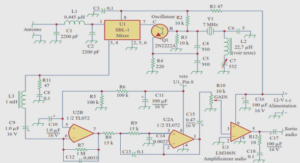Energy-efficient Opportunistic Spectrum Access in Cognitive Radio Networks
The traditional spectrum management is based on agreements between the SP and PUs. CR is considered as the key technology that enables unlicensed users to access the licensed spectrum. Furthermore, the new spectrum-licensing paradigm, initiated by the FCC in 2008 [8], has promoted the idea of using the CR technology to face the spectrum scarcity problem. It allows unlicensed users to access the spectrum as long as they do not harm licensed users’ transmissions. The model that we are studying in this chapter is suited for several use-cases of the CR paradigm in wireless networks. Firstly, this model allows ad-hoc connections to use spectrum holes (frequencies that are not utilized by PUs), as illustrated in Figure 4.1. Second, we may consider that SUs are CR base stations, which are able to sense the activity of a primary base station, and take advantage of spectrum holes for transmitting on the downlink (see Figure 4.2). Many works focused on the study of optimal OSA in CR networks (see [80], [81] and [82]). In [83], the authors focused on the OSA taking into account the energy consumption. They formulated their problem as a POMDP and derived some properties of the optimal OSA policy. Their control parameter is the duration of sensing used by a SU at each time slot in order to determine the PU’s activity. They provided heuristic control policies by using grid-based approximations, which have low complexity but give suboptimal control policies. Authors of [53] incorporated the energy constraint in the design of the optimal OSA policy. They formulated the problem also using a POMDP with a finite horizon criterion. They established a threshold structure of the optimal policy for the single channel model without providing analytical expression of the threshold. The main difference between these works and ours is that we consider not only the energy consumption, but also the transmission delay. Moreover, we consider a POMDP with an average reward criterion. Authors of [84] analyzed the latency of DSA in CR networks by considering a dedicated control with embedded control channel. In [85], authors considered an adaptive modulation scheme in order to guarantee a delay for SUs. The difference between their work and our’s is that they considered a dynamic spectrum sharing and we are considering an OSA context.
It is noteworthy that the impact of the energy consumption or the capacity of CR users to support additional QoS requirements such as the expected delay, to the best of our knowledge, has been somehow ignored in the literature, partially due to the difficulties in analyzing it. In fact, it is very important for today’s wireless networks to garantee a certain level of QoS. As SUs are not licensed to use the spectrum, the transmission delay of their packets depends not only on the PUs’ activity but also on the competition with each other. Our main contribution is to consider, in this CR setting, an optimal OSA mechanism that takes into account energy consumption and transmission delay. Note that, taking into account the delay as well as the energy consumption significantly complicates the optimization problem. For instance, without considering the delay constraint, the SU achieves the best tradeoff between trying to access licensed channel and sleeping to con- serve energy. However, the design of energy-QoS tradeoff lies among several conflicting objectives: gaining immediate access, gaining spectrum occupancy information, con- serving energy, and minimizing packet delays. The novelty of this work is to study an energy-QoS tradeoff OSA mechanism for SUs in a CR network. The major contributions of this chapter are:The organization of this chapter is as follows. In the next section, we describe the pri- mary and the secondary user models. Section 4.3 presents our Markov decision process framework. In Section 4.4, we study the existence of an optimal threshold policy for our opportunistic spectrum access with an energy-QoS tradeoff. We propose two learn- ing based protocols for the estimation of state transition rates in Section 4.5. Before concluding the chapter, we present, in Section 4.6, some numeric illustrations. In fact, SUs observe a ”good” channel (ON) if PUs are not using the licensed channel. On the other hand, the presence of PUs in the licensed channel results in a ”bad” channel (OFF) for SUs. Therefore, the licensed channels can be modeled by the ON/OFF Gilbert-Elliot model [88], [89]. The transition rates evolve as illustrated in Figure 5.1. Note that this model was used in several works in the OSA area (see [80], [27], [83] and [53] for some examples).






